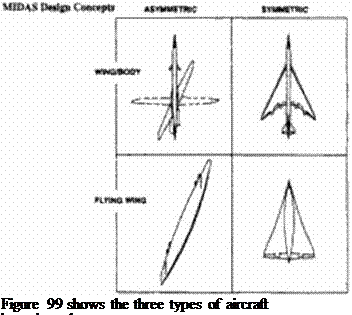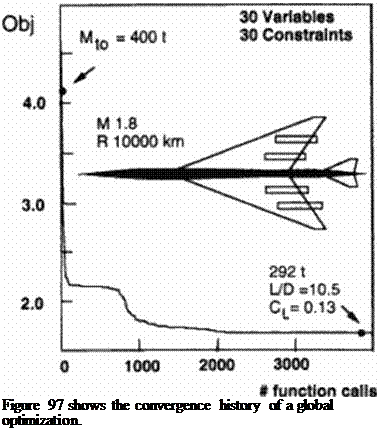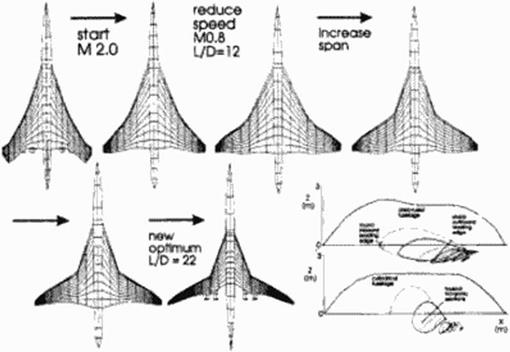Input requires more than 200 variables for a full definition of the aircraft. Roughly one third of
these variables are technology constants and are assumed to remain constant.
All designs were optimized with respect to the following 30 engine cycle, mission and
geometry variables:
• Maximum takeoff mass M
u>
• Powerplant Bypass ratio BPR. Maximum turbine entry temperature SLS T 4 ^ The corresponding total pressure ratio e. Combustor temperature cutback dunng takeoff u. Combustor temperature cutback at takeoff noise control point and start climb bj4xb The thrust
margin variable allows the engines to be oversized with respect to stan cruise. Noise suppression can be installed to achieve FAR 36.
• Mission. The flight profile is shown in Figure 100. Thrust, sweep, altitude and Mach number can be set at takeoff, takeoff thrust-cutback, midpoint climb, stan cruise and end cruise, as well as at holding and diversion. The landing and approach arc executed at maximum landing weight. For a specific mission segment definition point cither the Mach number or the altitude was fixed during the optimization. The variable mission thrust settings make it possible to meet the noise regulations with thrust • cutback. Since the design loads are calculated based on the prescribed mission it is possible to minimize the aircraft loads in conjunction with the geometry. The lift-off speed is not less than 1.2 limes the minimum control speed. In particular, the delta-wing configurations tend to take off at lift-off speeds greater than this value because of high take-off drag.
• Dimensions. Wing Area S. Wing Aspect ratio AR is only a design variable for wing-body configurations. For flying wings, the aspect ratio is determined by the wing area S and the wing thickness-to-chord ratio and the heuristic design rule that the payload should fit inside the structure without excess (vertical) space. Fuselage length is only a design variable for wing-body configurations. The configuration fineness ratio determines the fuselage diameter of SWB’s wings and the maximum absolute thickness of OFW’s. Wing Root thickness-lo – chord ratio r/c ^^ is an important variable to trade off wave drag against w ing weight. In the
case of the OFW the thickness always converged to values around 19 ^ This high value can probably only be achieved by employing boundar) layer control devices.
• Sweeps schedule. Cruise sweep Л f This is the same as the sweep for fixed sweep configurations. Climb sweep Л. . and take-off sweep Л are only of significance for variable
iiihw hi
sweep configurations. The sweep of the OFW is limited to 70° to avoid How separation.
• Пар schedule. Lilt increments due to Пар deflection at takeoff and landing. ЛС; r, and
AC. л і-
LJIapJ
• Component locations. Spanw ise location of two powerplants on half w mg: ^ and pr(lfty
Spanwise location of two fuel tanks on half wing: У{аяк1 and У1апГ and the spanwisc widths
of the tanks. The spanwisc location of the main gear leg[9] The x-location of the centroids
of these items is determined by balance considerations For flying wings the relative component location did turn out to be an important design variable to achieve the benefits of span loading.
Each of these variables are constrained to the domain of their validity. In addition a large number of constraints have to be satisfied.
• Geometry. The powerplants (4), gear legs (3) and fuel tanks (2) arc constrained to not interfere with each other’s location. The powerplants are placed outside the direct vicinity of the passenger cabin to protect passengers from engine explosion debris The gear track was limited to 35 m to enable operation from runways that arc at least 150 feet wide. The volume of the fuel tanks was sufficient to accommodate all the required fuel as well as a fuel volume
equivalent to half the pay load The mean trailing edge swccpback angle was limited to 30° for arrow wings due to the expected aero-elastic and control problems of more highly swept symmetric thin wings [356]. The maximum aircraft width and length is constrained to the current large aircraft gates at Frankfurt airport. This leads to a maximum structural span of about 120 m for OFW’s.
• Performance. The range was constrained lo a value not smaller than the design range. The takeoff field length and landing field length was constrained to 3300 ni (11000ft) to allow operations from most international runways. The one-cnginc out screen height climb requirement was set in accordance with the FAR25 regulations A minimum all engine climb gradient of 4% must be maintained at the takeoff FAR-36 cutback thrust level. The approach angle
.O
is 4 .
The width of the sonic boom carpet increases with Mach number, and therefore it will be much easier to use sonic boom corridors at the lower Mach numbers. Such a trip could involve going from Munich across the Adriatic sea (Ml.6 supersonic) to the Sinai Peninsula (M 1.15 boomlcss) through the red sea (M1.6) to India. At this time there are no models available to accurately predict the effects of aircraft effluents on the ozone layer.
2 % cruisefuel manoeuver
17.4 The Space of Optimized SCT’s
In this section we will compare optimized configurations. The companions arc made for designs
with fixed mission parameters, such as constant range, payload, and Mach number.














